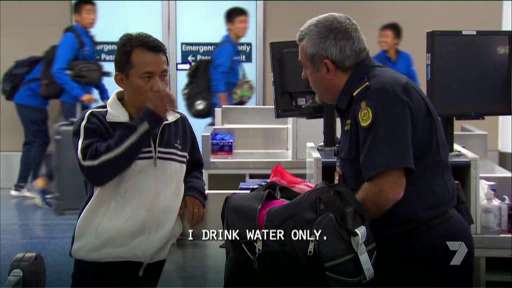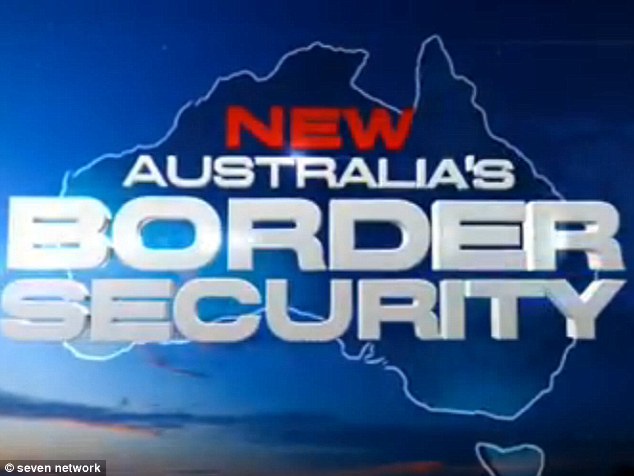Border Security: Australia’s Front Line is an Australian television based on real-life situations that airs on the Seven Network. The program follows the work of the officers who work for the Department of Home Affairs, Australian Border Force and the Australian Quarantine and Inspection Service. The show documents the enforcement of Australian immigration, customs, and quarantine and finance laws. Scenes from the Sydney mail centre are also sometimes shown. Most of the show is filmed at Brisbane, Melbourne and Sydney airports.
On occasion the show will feature locations such as the Perth airport, seaports, international mail centres and raids on workplaces that are suspected of contracting people in contradiction to the restrictions of their visa and immigrant status. The show also sometimes covers the work of the Australian Border Force vessels and aircraft in the waters off of Northern Australia. The show was renewed for a seventeenth season in 2018. There are more than 199 episodes of the show in total. The show has averaged viewership’s of more than 750,000 in past seasons, although this has begun to decline in recent years. The show first began airing in 2004 and was a quick rating hit for the network.
The first season of the show was hosted by Grant Bowler, who did not appear on camera in subsequent seasons of the show, although he did make a reappearance in 2010. Bowler provides the voice-over for every season of the show. The show originally aired on Wednesday nights and is classified PG. The show was later moved to a Sunday night 7:30 p m timeslot which helped the show grow its high ratings.
The show is also broadcast international in New Zealand, the United Kingdom, Ireland, Poland, Belgium, the Netherlands, Germany, Italy, Norway, Canada and several Asian countries.

What is the format of Border Security: Australia’s Front Line?
Border Security takes viewers behind the scenes of border enforcement activities. The show usually follows a few storylines, cutting between different events to give viewers an insight into border security, quarantine and immigration issues. The show runs for a half hour per episode.
https://www.youtube.com/watch?v=Z4C8lnPsppg
Controversies surrounding Border Security: Australia’s Front Line
The show has received its fair share of criticism since it first came to air. Writer Bob Burton criticised the edited format of the show, pointing out that it was at the discretion of the producers to remove anything that might be unflattering to the government agencies involved, or any mistakes made during post-production editing. This could give the false impression that government agencies were enforcing border security police in a more effective and fair manner than they might really be. During the 2009 season, the ABC show Media Watch suggested that the Department of Immigration and Citizenship had used the show and its working relationship with the Seven Network as leverage for an apology to National Communications Manager, Sandi Logan who had been portrayed in an unflattering light on Today Tonight. Media Watch suggested that the Department had threatened to pull their cooperation from the shows production, preventing future episode of Border Security episodes from moving forward.
The show again got into hot water in 2014 after the Department of Immigration and Citizenship detained American sex work activist Monica Jones in the Villawood Immigration Detention Centre after her tourist visa was cancelled at the Sydney airport. Jones commented later that the production team knew what would happen with border security, and that the cameras didn’t show up until 30 seconds later. This suggested that her detainment was a coordinated effort to get her on the TV show.
https://www.youtube.com/watch?v=4rP8rZvdYAM&list=PLyN01nElfGFnd304gXFhpq5sWLpThYdgk
A lot of the criticism aimed at the show is based on the fact that it is often perceived as sensationalising the work of border officials, and capitalising on anti-immigration sentiment in order to get ratings. The show is seen as a sign of the times, when immigration issues are increasingly at the top of social discourse and government agendas. The show is often critique as appealing to people’s fear and desire to control borders. Many critics also say that the show misrepresents what actually happens on the nation’s borders.
The show is often singled out as being responsible for giving people the impression that the country is under siege from large numbers of people willing to break the law, immigrate illegally and ignore regulations. The show however doesn’t give an accurate picture of the tens of thousands of people who pass through the borders of Australia without incident each day.
The executive producer of the American show however did not agree that the shows exaggerate the threat posed by illegal immigrants and border crossers. Pointing out that the series functions as more of a documentary series where cameras are rolling even when the crew is not there. He points out that there is drug bust on an almost daily basis under the watchful eyes of fly on the wall cameras.

Another criticism of the show is that it is not delivered with any balancing commentary, journalistic rigour or with a focus on objective fact. The show instead only shows the perspective of the border security professionals on the show, often portraying the people who are caught breaching the law as straight criminals. There is no real attempt to show the complexity of immigration and border security issues. The show often goes out of its way to humiliate the people on the screen, with critics pointing out that there is no due process and that as a viewer it is easy to judge them as guilty, because their side of the story is hidden. The ‘guilty-parties’ backgrounds are not covered in any real detail, making it too easy for the audience to dismiss them as the bad guys or villains.
Many critics also dismiss the show as government propaganda. Pointing out the fact that editorial control is in the hands of the government departments, making them embedded into the fabric of the show. The final say in how the government departments are portrayed does not sit with the production companies, making many feel that the show is an unexceptionally unbalanced vehicle for propaganda for government departments. The department’s lawyers even see each episode before it goes to air, preventing anything controversial about the government departments from being aired. Another criticism is the simple format of the sow which many feel does not leave time to explore the issues in detail on the show, and contributes to its sensationalist nature.

Spin-off’s from Border Security: Australia’s Front Line
There are a number of international spin-off’s from the show, including a Canadian and US version. The Canadian version of the show first began airing in 2012 and was cancelled after three seasons, after it was found to have breached Canadian privacy laws. The US version of the show, called Homeland Security USA only lasted for 13 episodes, two of which have never been aired on TV.
The UK version of the show is called Nothing To Declare and first began to air in 2011.
There is also a Latin version, called Alerta Aeropuerto which is filmed at El Dorado Airport, Bogota, Colombia and Jorge Chavez Airport in Lima, Peru.

